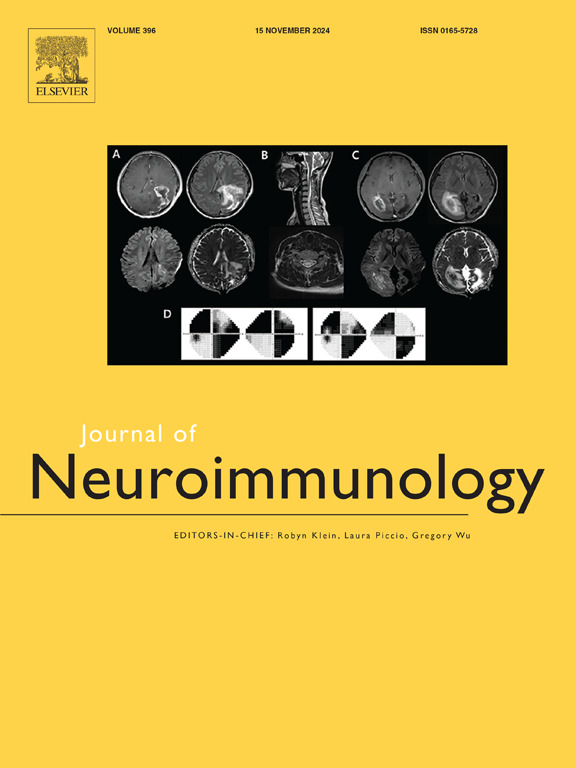Associations between serum levels of alpha-calcitonin gene-related peptide and clinical features of neuromyelitis optica spectrum disorders
IF 2.9
4区 医学
Q3 IMMUNOLOGY
引用次数: 0
Abstract
Neuromyelitis optica spectrum disorders (NMOSD) are characterized by severe inflammation-mediated astrocytopathy in the central nervous system. Neuropathic pain (NP) is highly prevalent among patients with NMOSD, and significantly impairs their quality of life. Alpha-calcitonin gene-related peptide (α-CGRP) is a neuropeptide related to pain and neuroinflammation in the central and peripheral nerves; however, the involvement of α-CGRP in NMOSD pathophysiology remains unexplored. Here, we measured serum levels of α-CGRP in 33 patients with NMOSD and 36 healthy controls by enzyme-linked immunosorbent assay to clarify associations between serum α-CGRP levels and clinical NMOSD features, including NP. The NMOSD patients showed significantly higher serum α-CGRP levels than healthy controls [median (interquartile range), ng/mL; 1.89 (1.66–2.39) vs 1.54 (1.34–1.87), p = 0.008]. NMOSD patients with sensory or bowel and bladder dysfunction had elevated serum α-CGRP levels compared with those without [2.02 (1.76–2.80) vs 1.76 (1.44–1.95), p = 0.049; 2.19 (1.96–2.86) vs 1.71 (1.40–1.90), p < 0.001, respectively]. Serum α-CGRP levels were higher in NMOSD patients with neuropathic pain than in those without [2.00 (1.71–2.76) vs 1.78 (1.51–1.97), p = 0.120]. NMOSD patients with spinal cord lesions on magnetic resonance imaging showed significantly higher serum α-CGRP levels compared with those without [2.02 (1.73–2.83) vs 1.73 (1.36–1.87), p = 0.044]. These findings indicate an association between α-CGRP and NMOSD pathophysiological status, especially sensory and bowel and bladder dysfunction derived from spinal cord lesions.
血清α -降钙素基因相关肽水平与视神经脊髓炎谱系障碍临床特征的关系
视神经脊髓炎谱系障碍(NMOSD)以中枢神经系统严重炎症介导的星形细胞病变为特征。神经性疼痛(NP)在NMOSD患者中非常普遍,并显著影响他们的生活质量。α-降钙素基因相关肽(α-CGRP)是中枢和周围神经中与疼痛和神经炎症相关的神经肽;然而,α-CGRP在NMOSD病理生理中的作用尚不清楚。在这里,我们用酶联免疫吸附法测定了33名NMOSD患者和36名健康对照者的血清α-CGRP水平,以阐明血清α-CGRP水平与NMOSD临床特征(包括NP)之间的关系。NMOSD患者血清α-CGRP水平明显高于健康对照组[中位数(四分位数范围),ng/mL;1.89(1.66 - -2.39)和1.54 (1.34 - -1.87),p = 0.008)。有感觉或肠道、膀胱功能障碍的NMOSD患者血清α-CGRP水平高于无功能障碍患者[2.02 (1.76 - 2.80)vs 1.76 (1.44-1.95), p = 0.049;2.19 (1.96-2.86) vs 1.71 (1.40-1.90), p <;分别为0.001)。有神经性疼痛的NMOSD患者血清α-CGRP水平高于无神经性疼痛的NMOSD患者[2.00 (1.71-2.76)vs 1.78 (1.51-1.97), p = 0.120]。有脊髓病变的NMOSD患者磁共振显示血清α-CGRP水平明显高于无脊髓病变的NMOSD患者[2.02 (1.73 - 2.83)vs 1.73 (1.36-1.87), p = 0.044]。这些发现表明α-CGRP与NMOSD病理生理状态,特别是脊髓病变引起的感觉和肠道和膀胱功能障碍之间存在关联。
本文章由计算机程序翻译,如有差异,请以英文原文为准。
求助全文
约1分钟内获得全文
求助全文
来源期刊

Journal of neuroimmunology
医学-免疫学
CiteScore
6.10
自引率
3.00%
发文量
154
审稿时长
37 days
期刊介绍:
The Journal of Neuroimmunology affords a forum for the publication of works applying immunologic methodology to the furtherance of the neurological sciences. Studies on all branches of the neurosciences, particularly fundamental and applied neurobiology, neurology, neuropathology, neurochemistry, neurovirology, neuroendocrinology, neuromuscular research, neuropharmacology and psychology, which involve either immunologic methodology (e.g. immunocytochemistry) or fundamental immunology (e.g. antibody and lymphocyte assays), are considered for publication.
 求助内容:
求助内容: 应助结果提醒方式:
应助结果提醒方式:


